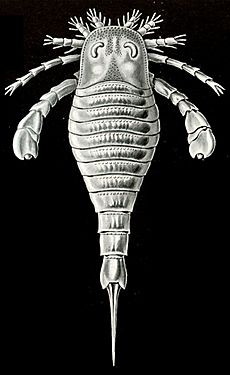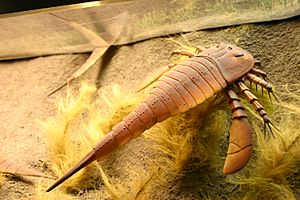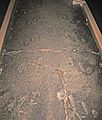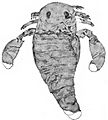Eurypterid facts for kids
Quick facts for kids EurypteridaTemporal range: Ordovician–Permian
|
|
|---|---|
 |
|
| Eurypterid from Ernst Haeckel's Kunstformen der Natur (1904) |
|
| Scientific classification | |
| Kingdom: | |
| Phylum: | |
| Subphylum: | |
| Class: | |
| Order: |
† Eurypterida
|
The eurypterids were a group of ancient animals. They are now extinct, meaning they no longer live on Earth. These creatures were related to modern-day spiders and scorpions. They were also the largest arthropods ever known!
Some eurypterids, like Jaekelopterus, could grow up to 2.5 meters (about 8 feet) long. That's longer than a tall person! Most species were smaller, usually less than 20 cm (8 inches). Eurypterids were predators, meaning they hunted other animals for food. They lived in warm, shallow seas and lakes. These amazing creatures thrived from about 460 to 248 million years ago. This time period spans the Ordovician to the Permian periods. Scientists think their eyesight was not very good.
Over time, some eurypterids moved from saltwater to freshwater. This likely happened by the Pennsylvanian period. All eurypterids died out during a huge event called the Permian–Triassic extinction event. This happened about 251 million years ago. Their fossils have been found all over the world.
What Did Eurypterids Look Like?
A typical eurypterid had a large, flat, and somewhat rounded head shield. This part is called a carapace. Behind the carapace was a body section made of many joints. Finally, they had a tail that got thinner towards the end. Most eurypterids had a long, sharp spine at the tip of their tail. However, some, like Pterygotus, had a wide, flat tail. This flat tail might have helped them swim.
Behind their head, eurypterids had twelve body segments. Each segment was made of two plates. There was a top plate called a tergite and a bottom plate called a sternite. The tail part, which often had a spike, is known as the telson.
New Discoveries: Pentecopterus
Scientists recently found a new fossil species of eurypterid. They named it Pentecopterus. This creature was also very large, about two meters (6.5 feet) long. It lived 467 million years ago, during the Middle Ordovician period. This makes Pentecopterus one of the earliest known eurypterids. Its discovery helps us learn more about these ancient sea scorpions.
Images for kids
-
Restoration of Eurypterus with body parts labelled
-
The holotype of Palmichnium kosinkiorum, containing the largest eurypterid footprints known.
-
The supposed "gill tracts" of eurypterids have been compared to the air-breathing pseudotracheae present in the posterior legs of modern isopods, such as Oniscus (pictured).
-
Pterygotus depicted hunting Birkenia.
-
Reconstruction of Adelophthalmus, the only eurypterine (with swimming paddles) eurypterid to survive the Late Devonian extinction and persist into the subsequent Carboniferous and Permian periods.
-
Figure of Eurypterus remipes by James E. De Kay (1825).
-
Evolutionary tree of eurypterids as imagined by John Mason Clarke and Rudolf Ruedemann in 1912.
See also
 In Spanish: Euriptéridos para niños
In Spanish: Euriptéridos para niños












